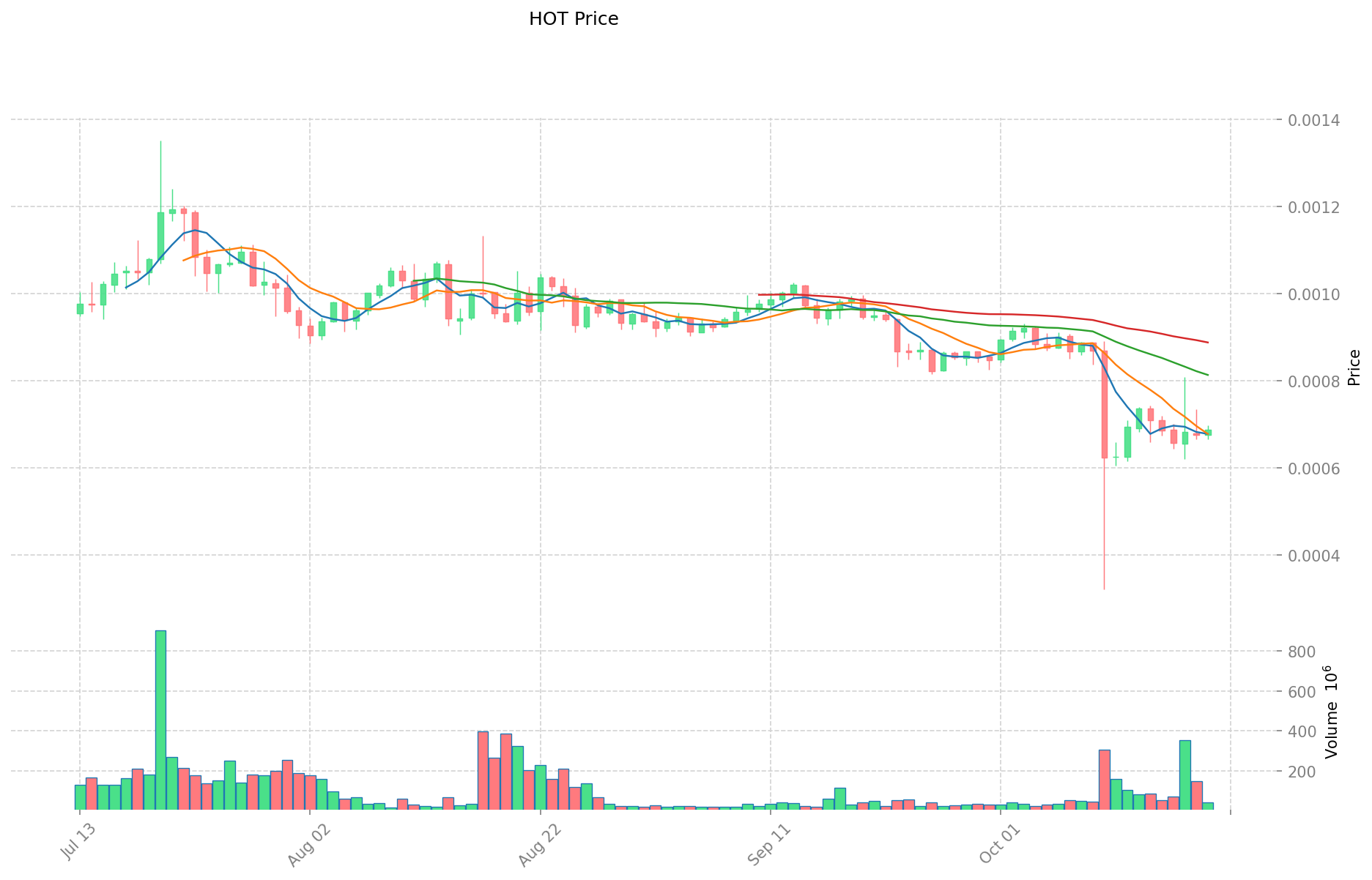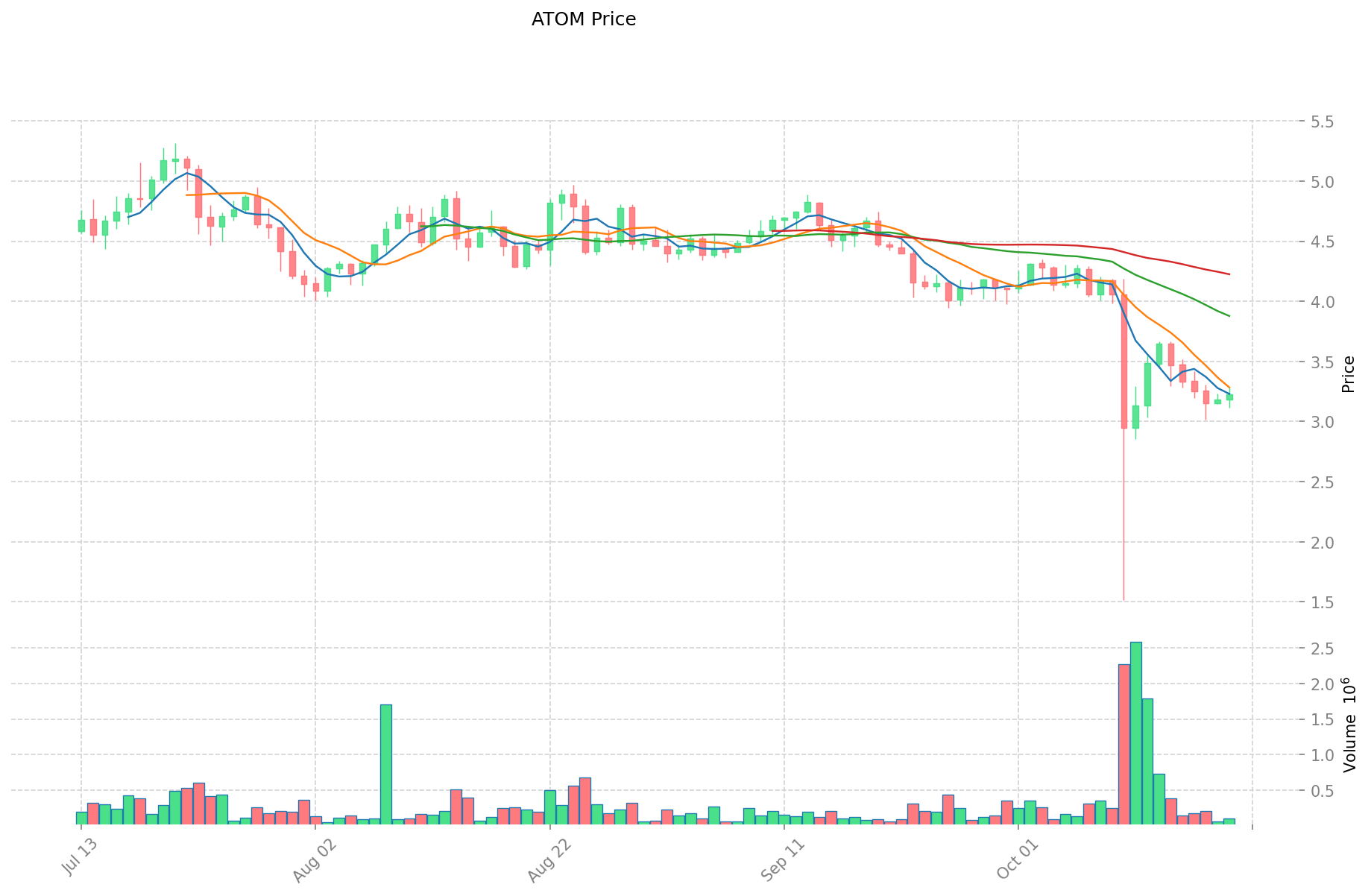HOT vs ATOM: İki Popüler Metin Editörünün Performans ve Özellikleri Karşılaştırılıyor

Giriş: HOT ile ATOM Yatırımı Karşılaştırması
Kripto para piyasasında HOT ile ATOM karşılaştırması, yatırımcıların gündeminden hiç düşmeyen bir konudur. Her iki varlık, piyasa değeri sıralaması, uygulama alanları ve fiyat performansı açısından belirgin farklılıklar gösterirken, kripto varlık dünyasında farklı konumlandırmaları temsil eder.
Holo (HOT): 2018’de piyasaya sürülmesinden bu yana, Holochain uygulamaları için dağıtık eşler arası (P2P) barındırma platformuyla piyasa tarafından kabul görmüştür.
Cosmos (ATOM): 2019’dan beri “Blokzincirlerin İnterneti” olarak adlandırılmakta olup, farklı blokzincir ağları arasında iletişimi kolaylaştırmayı amaçlamaktadır.
Bu makalede HOT ve ATOM’un yatırım değerleri kapsamlı biçimde karşılaştırılacak; tarihsel fiyat eğilimleri, arz mekanizmaları, kurumsal benimseme, teknolojik ekosistemler ve gelecek öngörüleri incelenecek, yatırımcıların en çok merak ettiği şu soruya yanıt aranacaktır:
“Şu anda hangisi daha iyi bir tercih?”
I. Fiyat Geçmişi Karşılaştırması ve Güncel Piyasa Durumu
HOT ve ATOM Tarihsel Fiyat Eğilimleri
- 2021: HOT, 6 Nisan 2021 tarihinde $0,03126682 ile tüm zamanların en yüksek seviyesine ulaştı; bu yükseliş, genel kripto piyasasındaki olumlu seyirden kaynaklanmış olabilir.
- 2022: ATOM, 17 Ocak 2022’de $44,45 ile zirve yaptı; Cosmos ekosisteminin artan benimsenmesi etkili olmuş olabilir.
- Karşılaştırmalı analiz: Son ayı piyasasında, HOT zirveden $0,0006828 düzeyine inerken, ATOM ise zirveden $3,22 seviyesine geriledi.
Güncel Piyasa Durumu (20 Ekim 2025)
- HOT güncel fiyatı: $0,0006828
- ATOM güncel fiyatı: $3,22
- 24 saatlik işlem hacmi: HOT $27.701,84 | ATOM $305.833,96
- Piyasa duyarlılık endeksi (Korku & Açgözlülük Endeksi): 29 (Korku)
Canlı fiyatları görmek için tıklayın:
- HOT güncel fiyatı için Piyasa Fiyatı
- ATOM güncel fiyatı için Piyasa Fiyatı


II. HOT ile ATOM’un Yatırım Değerini Etkileyen Temel Faktörler
Arz Mekanizması Karşılaştırması (Tokenomik)
- HOT: Toplamda sabit 177.619.433.541 HOT token arzı, yeni ihraç yapılmıyor
- ATOM: Enflasyonist model, dinamik arz; yıllık enflasyon oranı staking katılımına bağlı olarak %7-20 arasında değişiyor
- 📌 Tarihsel Örüntü: HOT’un sabit arzı boğa piyasalarında kıtlık değeri yaratırken; ATOM’un enflasyonist modeli, staker’lara ödül sağlasa da ağ büyümesi yetersizse fiyat üzerinde baskı yaratabilir.
Kurumsal Benimseme ve Piyasa Uygulamaları
- Kurumsal Portföyler: ATOM, kripto yatırım fonları ve borsa yatırım ürünlerinde daha fazla kurumsal ilgi görüyor
- Kurumsal Kullanım: ATOM’un birlikte çalışabilirlik özellikleri, zincirler arası mutabakatlarda kurumsal uygulamaları cezbetmektedir; HOT’un ajan-merkezli mimarisi ise dağıtık uygulamalarda farklı kullanım senaryolarına hitap eder
- Regülasyon Tutumu: Her iki token büyük piyasalarda benzer düzenleyici incelemeyle karşılaşsa da, ATOM’un proof-of-stake konsensüsü, çevresel regülasyon baskısını azaltabilir
Teknik Gelişim ve Ekosistem Oluşumu
- HOT Teknik Güncellemeleri: Holochain altyapısını geliştirerek dağıtık hesaplama sağlayan ve geleneksel blokzincir limitlerini aşan bir sistem oluşturuyor
- ATOM Teknik Gelişim: Cosmos ekosisteminde zincirler arası birlikte çalışabilirlik sunan Inter-Blockchain Communication (IBC) protokolü sürekli olarak geliştiriliyor
- Ekosistem Karşılaştırması: ATOM, çok sayıda IBC uyumlu zincir, DeFi protokolü ve zincirler arası güvenlik özellikleriyle daha gelişmiş bir ekosisteme sahip; HOT ekosistemi ise ağırlıklı olarak Holochain geliştirme altyapısına odaklanıyor
Makroekonomik Faktörler ve Piyasa Döngüleri
- Enflasyon Performansı: ATOM’un staking ödülleri enflasyon etkilerini telafi eden getiri sunarken, HOT benzer bir getiri mekanizmasına sahip değil
- Para Politikası Etkileri: Her iki token, FED kararları ve faiz değişikliklerine hassas; riskten kaçış ortamlarında düşük piyasa değerli HOT daha fazla etkileniyor
- Jeopolitik Faktörler: ATOM’un birlikte çalışabilirlik stratejisi, bölgesel regülasyon değişikliklerine karşı daha dayanıklı olmasını sağlayabilir
III. 2025-2030 Fiyat Tahmini: HOT ile ATOM
Kısa Vadeli Tahmin (2025)
- HOT: Temkinli $0,0006384-$0,000672 | İyimser $0,00096096
- ATOM: Temkinli $2,02734-$3,218 | İyimser $4,15122
Orta Vadeli Tahmin (2027)
- HOT büyüme aşamasına geçebilir, tahmini fiyat aralığı: $0,000726993792-$0,001029907872
- ATOM boğa piyasasına girebilir, tahmini fiyat aralığı: $3,7548018205-$5,484541985
- Başlıca etkenler: Kurumsal sermaye girişi, ETF, ekosistem büyümesi
Uzun Vadeli Tahmin (2030)
- HOT: Temel senaryo $0,001200626352878 | İyimser senaryo $0,001248651406993
- ATOM: Temel senaryo $7,044319357543687 | İyimser senaryo $7,748751293298056
Yasal Uyarı
HOT:
| Yıl | Tahmini En Yüksek Fiyat | Tahmini Ortalama Fiyat | Tahmini En Düşük Fiyat | Değişim Oranı |
|---|---|---|---|---|
| 2025 | 0,00096096 | 0,000672 | 0,0006384 | -1 |
| 2026 | 0,0009144576 | 0,00081648 | 0,0004408992 | 19 |
| 2027 | 0,001029907872 | 0,0008654688 | 0,000726993792 | 26 |
| 2028 | 0,00138362497056 | 0,000947688336 | 0,00070128936864 | 38 |
| 2029 | 0,001235596052476 | 0,00116565665328 | 0,001014121288353 | 70 |
| 2030 | 0,001248651406993 | 0,001200626352878 | 0,000864450974072 | 75 |
ATOM:
| Yıl | Tahmini En Yüksek Fiyat | Tahmini Ortalama Fiyat | Tahmini En Düşük Fiyat | Değişim Oranı |
|---|---|---|---|---|
| 2025 | 4,15122 | 3,218 | 2,02734 | 0 |
| 2026 | 4,7531469 | 3,68461 | 2,1370738 | 14 |
| 2027 | 5,484541985 | 4,21887845 | 3,7548018205 | 31 |
| 2028 | 6,937945611025 | 4,8517102175 | 3,39619715225 | 50 |
| 2029 | 8,193810800824875 | 5,8948279142625 | 4,185327819126375 | 83 |
| 2030 | 7,748751293298056 | 7,044319357543687 | 6,199001034638445 | 118 |
IV. Yatırım Stratejisi Karşılaştırması: HOT ile ATOM
Uzun Vadeli ve Kısa Vadeli Yatırım Stratejileri
- HOT: Dağıtık hesaplama potansiyeline ve uzun vadeli ekosistem büyümesine odaklanan yatırımcılar için daha uygun
- ATOM: Birlikte çalışabilirlik çözümleri ve staking yoluyla getiri arayan yatırımcılar için ideal
Risk Yönetimi ve Varlık Dağılımı
- Temkinli yatırımcı: HOT %20 – ATOM %80
- Agresif yatırımcı: HOT %40 – ATOM %60
- Koruma araçları: Stablecoin tahsisi, opsiyonlar, çapraz para portföyleri
V. Potansiyel Risk Karşılaştırması
Piyasa Riskleri
- HOT: Düşük piyasa değeri ve likidite nedeniyle yüksek oynaklık riski
- ATOM: Ağ büyümesi yeterli olmazsa, enflasyonist tokenomik sebebiyle değer seyrelmesi riski
Teknik Riskler
- HOT: Ölçeklenebilirlik, ağ istikrarı ve Holochain altyapısının benimsenme riski
- ATOM: Zincirler arası güvenlik açıkları ve çok zincirli ekosistemde konsensüs sorunları
Düzenleyici Riskler
- Küresel regülasyon politikaları her ikisini de etkileyebilir; ATOM, proof-of-stake konsensüsü ve gelişmiş ekosistemiyle daha az incelemeyle karşılaşabilir
VI. Sonuç: Hangisi Daha İyi Tercih?
📌 Yatırım Değeri Özeti:
- HOT avantajları: Benzersiz dağıtık hesaplama yaklaşımı ve sabit arz tokenomik
- ATOM avantajları: Yerleşmiş birlikte çalışabilirlik ekosistemi, staking getirileri, kurumsal benimseme
✅ Yatırım Tavsiyesi:
- Yeni yatırımcılar: Yerleşik ekosistem ve staking avantajları nedeniyle ATOM’a daha yüksek oranla yatırım yapılabilir
- Tecrübeli yatırımcılar: HOT’un büyüme potansiyeli ve ATOM’un ekosistem istikrarı ile dengeli portföy yaklaşımı uygundur
- Kurumsal yatırımcılar: Daha büyük piyasa değeri, likidite ve kurumsal altyapı nedeniyle ATOM daha cazip olabilir
⚠️ Risk Uyarısı: Kripto para piyasası yüksek volatiliteye sahiptir. Bu makale yatırım tavsiyesi değildir. None
VII. Sıkça Sorulan Sorular
S1: HOT ve ATOM arasındaki temel farklılıklar nelerdir? C: HOT, sabit arz ile dağıtık hesaplamaya odaklanırken; ATOM, enflasyonist modelle blokzincirler arası birlikte çalışabilirliği hedefler. ATOM, daha gelişmiş ekosisteme ve yüksek kurumsal benimsemeye sahiptir.
S2: Hangi token tarihsel olarak daha iyi performans gösterdi? C: ATOM, Ocak 2022’de $44,45 ile zirveye ulaşarak HOT’a göre daha iyi bir performans sergiledi. HOT ise Nisan 2021’de $0,03126682 ile en yüksek seviyesine çıktı.
S3: HOT ve ATOM’un tokenomikleri nasıl farklılık gösteriyor? C: HOT’un toplam arzı 177.619.433.541 ile sabitken; ATOM, staking katılımına göre yıllık %7-20 arasında değişen enflasyonist bir model benimser.
S4: Hangi token uzun vadeli yatırım için daha uygun? C: ATOM, gelişmiş ekosistemi, staking avantajları ve kurumsal benimsenmesiyle genelde uzun vadeli yatırım için daha uygun kabul edilir. HOT ise, risk seven yatırımcılar için daha yüksek büyüme potansiyeli sunabilir.
S5: HOT ve ATOM’a yatırımda başlıca riskler nelerdir? C: HOT, yüksek volatilite ve benimseme riski taşırken; ATOM, enflasyonist model nedeniyle değer seyrelmesi riskiyle karşı karşıyadır. Her iki token, kripto para alanına özgü piyasa, teknik ve regülasyon risklerine tabidir.
S6: Kurumsal yatırımcılar HOT ve ATOM’a nasıl bakıyor? C: Kurumsal yatırımcılar, daha büyük piyasa değeri, yüksek likidite ve yerleşik ekosistem nedeniyle ATOM’u daha fazla tercih eder. HOT’un kurumsal ilgisi ise ATOM’a göre daha düşüktür.
S7: 2030 yılı için HOT ve ATOM fiyat tahminleri nedir? C: 2030’da HOT’un temel senaryoda $0,001200626352878, ATOM’un ise $7,044319357543687 seviyelerine ulaşması öngörülüyor. Bu tahminler tamamen spekülatif olup piyasa koşullarına bağlıdır.

NRN ve ATOM: Doğal Dil İşleme Alanında İki Modern Sinir Ağ Mimarisi Karşılaştırması

Agoric (BLD) iyi bir yatırım mı?: Bu blokzincir platformunun potansiyelini ve risklerini inceliyoruz

Hedera (HBAR) 2025 Fiyat Analizi ve Yatırım Olanakları

Sei Network 2025 Gelişim Durumu ve Yatırım Fırsatı Analizi

2025'te SEI Ekosisteminin Gelişim Durumu ve Yatırım Fırsatlarının Analizi

Sui Fiyat Pazar Analizi ve 2025'te Uzun Vadeli Yatırım Potansiyeli

Kripto ticaretinde Head and Shoulders formasyonunda uzmanlaşmak

Blockchain sistemlerinde kimliğinizi doğrulamanın yolları

Layer 0 Mimarisi: Ana Ağlar ve Yan Zincirler ile Blockchain Yeniliğinde Yeni Bir Dönem

NFT Sanatı Oluşturmak İçin Kullanılabilecek En İyi Yapay Zekâ Araçları

Kripto Dolandırıcılıklarını Tespit Etmeye Yönelik Meme Rehberi: Tespit ve Önleme Araçları
